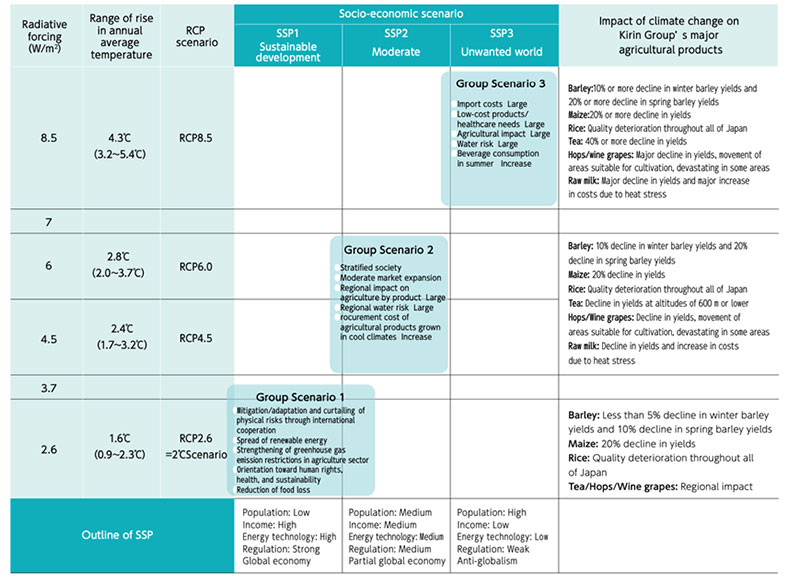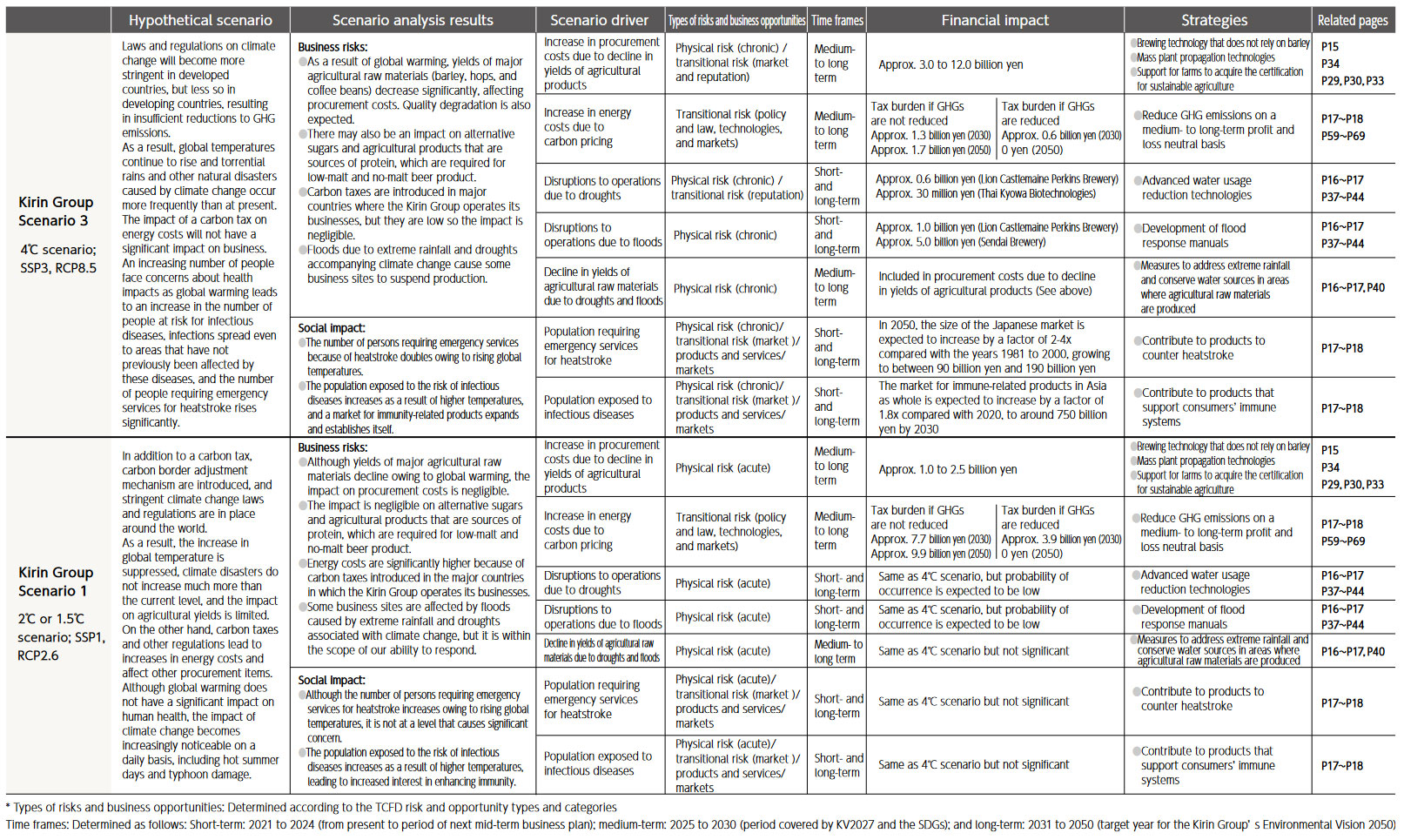Footnote
(Note 1) Trajectories created by fixing the pathways for greenhouse gas concentration. RCP stands for Representative Concentration Pathways, and the higher the number following the RCP is, the greater the radiative forcing (the effect of causing global warming) is assumed to be in 2100.
(A-PLAT: “How to Read the Graphs”https://adaptation-platform.nies.go.jp/map/guide/about_graphs.html)
(Note 2) A new socio-economic scenario developed by the Integrated Assessment Modeling Consortium. SSP stands for Shared Socioeconomic Pathways.
(National Institute for Environmental Studies “Publication of Shared Socioeconomic Pathways (SSPs) Used in Interdisciplinary Research on Climate Change” :https://www.nies.go.jp/whatsnew/20170221/20170221.html)
(Note 3) Of the three group scenarios, Group Scenario 1 (corresponding to RCP2.6) and Group Scenario 3 (corresponding to RCP8.5) were addressed. From 2019, Group Scenario 3 (corresponding to RCP8.5) has been referred to as the "2°C Scenario" and Group Scenario 3 as the "4°C Scenario".
(Note 4) The certification is given only to farms that meet comprehensive standards for sustainable forest management and farm management through the protection of wildlife, conservation of soil and water resources, limitation of pesticides and management of waste, appropriate salaries for workers, improvement of the lives of workers, their families and local communities, and guarantee of medical care and education for children.
(Kirin Holdings Company, Limited News:https://www.kirinholdings.com/jp/newsroom/release/2015/0901_03.html)
(Note 5) FSC (Forest Stewardship Council®) is an international organization that certifies the world's forests that produce timber, as well as the distribution and processing processes of timber cut from those forests.
(Kirin Holdings Company, Limited News:https://www.kirinholdings.com/jp/newsroom/release/2017/0227_01.html)
Scenario Analysis Based on TCFD Recommendations and Reflection in Strategies
Kirin Holdings Company, Limited
| Updated | March 18, 2022 (Posted on December 15, 2022) |
|---|---|
| Publication date | December 16, 2021 |
| Sector | Industrial and economic activities |
Company Overview

We, Kirin Holdings Company, Limited has established itself as one of the Japan’s leading beer manufacturers in our founding business of beer brewing. It has continuing to expand overseas, and also became one of the top leading brands in Asia and Oceania. By utilizing the knowledge gained from beer production, we have expanded our business into the food industry including soft drinks, by utilizing the expertise gained through beer production, and have also expanded into the medical/health science fields since the 1980s.
Climate Change Impacts
In the Kirin Group's Environmental Vision 2050, we identified four fundamental issues: water resources, biological resources, containers and packaging, and climate change, with climate change being a critical issue that will have a significant impact on the entire society and corporate operations.
Adaptation Initiatives
Our company is engaged in a variety of activities to address climate change. In 2018, our Group became the first Japanese food and beverage company to endorse the recommendations of the TCFD.
As our businesses are dependent on the benefits of natural capital, we had conducted various risk analyses before the publication of the final TCFD recommendations at the end of June 2017, and were therefore able to disclose the results of our scenario analysis and other information in line with the TCFD recommendations in our Environmental Report 2018 (Fig. 1). In this scenario analysis, we used three group scenarios (Fig. 2) combining RCP scenarios (Note 1) and SSP scenarios (Note 2) to investigate and evaluate the impact on agricultural yields.
In 2019, for two of the three group scenarios that corresponds to RCP2.6 and RCP8.5 (Note 3), we assessed: the impact on agricultural raw materials in 2050 and 2100, water stress/water risk surveys at agricultural production sites, production and distribution facilities, and the financial impact of carbon pricing.
After 2020, in addition to estimating the financial impact of declines in agricultural yields on procurement costs and the financial impact of water risk/stress on production facilities, we have also been estimating the business opportunities related to heat stroke and infectious diseases caused by climate change (Fig. 3).
Effects / Expected Benefits
In 2018, the torrential rain in western Japan (2018 West Japan Torrential Rain Disaster) caused a significant impact, stopping deliveries at the peak of the business season. Based on the results of the scenario analysis in TCFD recommendations, a manual for similar disasters was prepared and implemented in the fall of 2018. We were able to avoid major impacts from Typhoons No. 15 (2019 Boso Peninsula Typhoon) and No. 19 (2019 East Japan Typhoon).
The results of the scenario analysis are also reflected in our management strategies (Fig. 4).
Various environmental issues including climate change need to be incorporated into the management strategies of each operating companies. We plan to revise our “CSV Commitments”, which clarifies our medium/long-term vision that we aim to achieve through our business.Furthermore, it has been reflected in our mid-term business vision “The Kirin Group Vision 2027 (KV2027)” starting from FY2022.

Fig. 1 Scenario analysis until 2020

Fig. 2 “Kirin Group Environmental Report 2018” scenario analysis

Fig. 3 Results of the scenario analysis in 2021

Fig. 4 Examples of CSV reflected in products representing the brand

